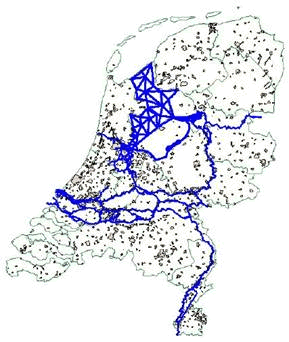National cooling water discharge modelling system
Introduction
Restricting the discharge of cooling water is a current issue due to the recent hot summers and the expected climate change. Water managers are facing questions regarding cooling water discharge, distribution, environmental effects, assessment of permits, the distribution of heat discharge amongst companies, etc. A new assessment system for heat discharge was set up in 2004 under the banner of NBW, which is now being implemented. The receiving water has been given a pivotal position in this new system. Insight is obtained into the way the water system works and the effects that heat discharge has on this by using models. Three-dimensional models are used to obtain detailed considerations of the effects of heat discharge. Such detailed models cannot, however, be used to obtain a national or regional picture. A relatively simple but national one-dimensional modelling system was developed for this reason in 2003 that can be used to calculate the temperature of the National Waterways under the influence of meteorology and cooling water discharge.
Objectives
The modelling system consists of a national SOBEK model including the DELWAQ (water quality) module. Water temperature as well as water movement can be one-dimensionally calculated with regard to space and time with this modelling system. The modelling system must offer support when answering questions related to the following three fields.
- Support for policy and research questions:
- Long-term trends with regard to climate change.
- Determining the optimal distribution of cooling water use. Where can I first best cut back when there are droughts? Where is the best place to expand capacity?
- What is the effect of upstream discharging? Bring mutual influencing into vision.
- Support for water management
- Early warning with regard to impending problems.
- Determining the best distribution of cooling water use. Where can I first best cut back when there are droughts? Where is the best place to expand capacity? In this case, in the short-term to ensure that standards are not exceeded.
- Assess the effectiveness of possible measures.
- Permit issue/enforcement
- One-dimensional preconditions for local calculations to be performed by the entities responsible for discharges for the assessment of permits.
The model
A national hydrodynamic SOBEK model forms the basis for the model. The national model is a combination of different (already existing) SOBEK submodels and covers the Maas, branches of the Rhine (Waal, Nederrijn, Lek and IJssel), the Northern Delta Area, Amsterdam-Rijnkanaal and Noordzeekanaal waterways, Markermeer, IJsselmeer, Randmeren and Vecht (see the figure).

The development of the temperature module was started in 2003. This module has been tested for the Maas. The model was further extended due to the good results so that the national model could be verified in 2006.
The temperature of the surface water is calculated by using two modules;
- A process in which the natural temperature is calculated with a heat balance based on meteorology and, if required, discharges.
- A second process calculates the cooling of the water which with regard to the background temperature has increased, usually specifically as a result of heat discharge.
In principle, the full heat balance can be calculated by using the first process. The decision was, however, taken to determine the increase of the heat temperature as the result of discharges and the cooling that follows from this by using the second process to obtain a practical presentation. In this way you can distinguish between the contributions made by meteorology issues and the discharges. A full description is given of the theory behind this in (SOBEK national temperature model, 2004).
The data that must be specifically collected for temperature modelling can be subdivided into three groups; meteorology, cooling water discharge and preconditions:
- The meteorological variables are global radiation, wind speed, air temperature and humidity, hours of sunshine and air pressure.
- The cooling water discharges are shown in the model as heat load (using the MW unit) in which the flow, in-take and discharge temperature have been taken into account. 70 important industrial discharges have been included in the national model.
- The temperature at the edges of the model must be available or must be estimated as well as the temperature of lateral discharges.
Information
The modelling system has not yet been fully developed. A few areas that require improvement have emerged from its verification. A link to three-dimensional models is being considered for the long-term. These are existing local models around power stations or systems influenced by the tide. Despite these developments, the current model is operational and the schematisation can be supplied to interested parties. You will, however, require a licence for the SOBEK calculation core.
For more information you can contact the Helpdesk Water:
Telephone: 0031-320-299999
E-mail: Helpdesk Water